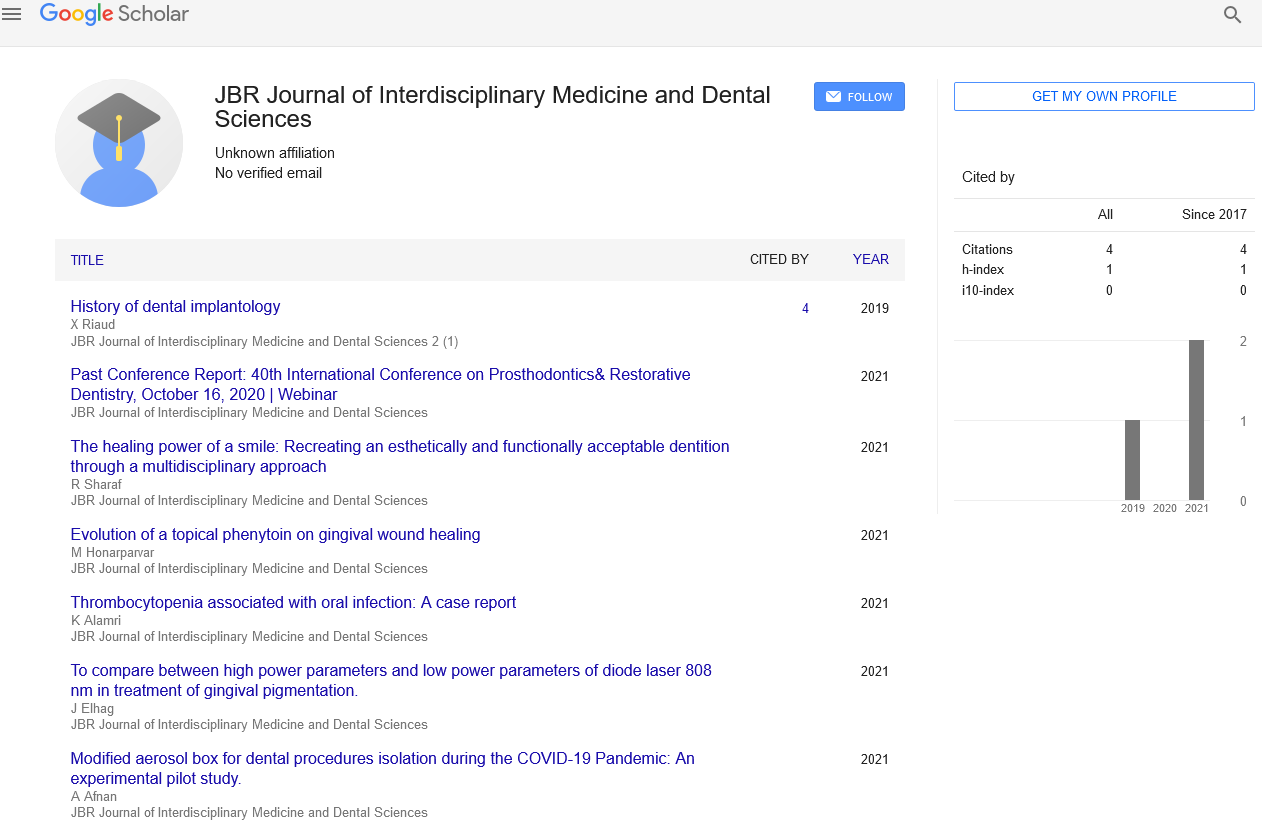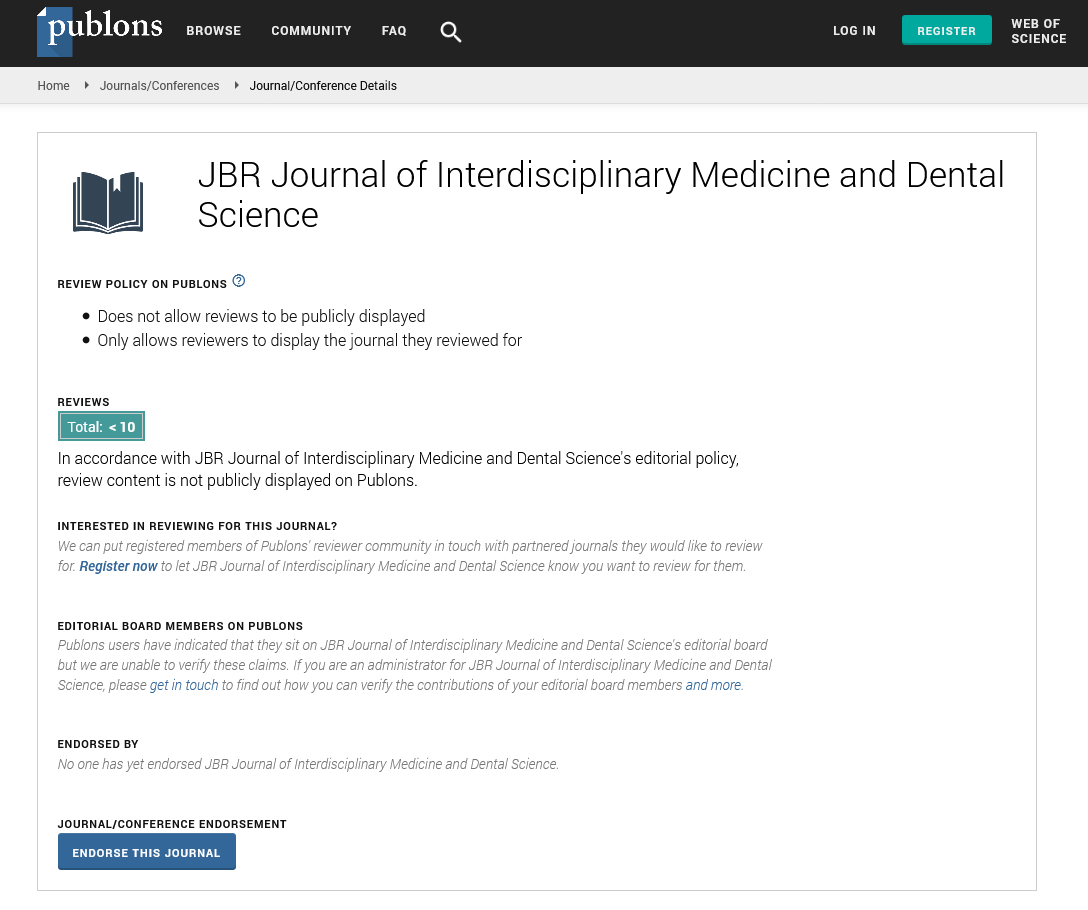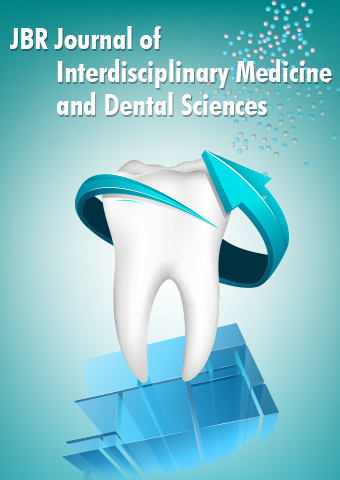Review Article - JBR Journal of Interdisciplinary Medicine and Dental Sciences (2023) Volume 6, Issue 1
Dietetic practise that crosses professions, disciplines, and sectors Family Medicine Interdisciplinary
Sarikaya Umut*
Amasya Oral and Dental Health Center, Turkey
Amasya Oral and Dental Health Center, Turkey
E-mail: umutsarikaya@rediff.com
Received: 02-Jan-2023, Manuscript No. JIMDS-23-85877; Editor assigned: 04-Jan-2023, PreQC No. JIMDS-23-85877(PQ); Reviewed: 18-Jan-2023, QC No. JIMDS-23-85877; Revised: 23-Jan-2023, Manuscript No. JIMDS-23-85877(R); Published: 30-Jan-2023, DOI: 10.37532/2376- 032X.2023.6(1).11-14
Abstract
When delivering patient care, it is especially important to take into account the fact that geriatric patients are more likely to have several medical comorbidities, physical restrictions, and mental impairments. Dentistry programmes, like those for other health care professions, include interprofessional education (IPE) activities to provide students the skills they need to offer team-based treatment in the future. To give students useful IPE experiences, health professional programmes should take into account geriatric training in simulated learning settings, adult day programmes, nursing homes, long-term care facilities, and home care experiences. Finally, this essay makes a suggestion that professional associations take into account providing IPE-related continuing education programmes [1].
Keywords
Collaborative practice ▪ Geriatric dental medicine ▪ Interprofessional education (IPE) ▪ Team-based care
Introduction
The setting in which practise takes place creates a web of linkages within which dietetics functions. The patient is the main emphasis in healthcare settings, and teamwork is crucial. When health care teams collaborate with the patient to address complicated issues, choosing the best course of action for treatment, this is known as inter-professional practise. Working with the best evidence in clinical and other contexts necessitates the integration of practise with scientific research, but this research may and must come from a variety of disciplines. While scientific disciplines uphold the norms and guarantee rigour for knowledge development, an interdisciplinary approach is required to advance the breadth of information that is now accessible for translation to practise [2]. Nutrition research itself represents a variety of discipline skills from the laboratory bench to the community and beyond. Finally, safeguarding health needs activism beyond the health system in addition to applying health sciences to practise. Thus, intersectoral areas are pushed into practise. In light of this, WHO acknowledges the necessity of addressing the social determinants of health and equity concerns in order to take effective and long-lasting action on health. While keeping a sense of how it all fits together, these factors dramatically broaden the area of study in dietetic practise [3].
Interdisciplinary education has been promoted by writers in the fields of medicine, nursing, pharmacy, and mental health throughout the majority of my career. They argue about how health professionals are socialised to operate in a disjointed healthcare system with inadequate cooperation and communication, and that they are taught in discipline-specific silos. It has become evident that conventional educational approaches do not consistently result in graduates who are able to function as teams as we progress toward a new primary care system based on the patient-centered medical home (PCMH). But several obstacles have so far impeded the development of multidisciplinary health professions education. The creation of such models is costly. Issues with professional grass limit alternatives [4]. Well-intentioned attempts are thwarted by logistical obstacles, such variations in course timetables. In light of this, multidisciplinary primary care education still occurs seldom despite long-term success in disciplines like geriatrics and palliative care. Maybe it’s time to change how we’re going about things. Since their inception, multidisciplinary faculty members have been a part of family medicine residencies. More than 30 years ago, I had to take obligatory classes from surgeons, paediatricians, obstetricians, and internists as part of my residency. Psychologists and social workers taught me about doctorpatient communication and counselling techniques. My first encounters with faculty development were learning from non-physicians and experts in business management. Our residencies, built on the rotating internship model, were created to integrate many viewpoints about the job of the family physician [5]. While this has never been the case in family medicine, residents in other medical specialties spend almost all of their time learning from experts in their respective disciplines. Currently, STFM has 4,596 members, with about three-quarters of them being physicians. However, we also have members who work in the fields of nursing, pharmacy, social work, education, psychology, nutrition, statistics, and epidemiology [6].
Over the past 50 years, the science of nutrition has developed quickly. There is now solid evidence that lifestyle practises, such as eating habits and physical activity patterns, have an impact on health and illness and are linked to the top killers in the United States. This is especially true in an era where the practise of evidence-based medicine is required. National policies that stress dietary advice for the prevention and treatment of illnesses, particularly chronic diseases like cardiovascular disease, diabetes, cancer, and obesity, have been developed with the use of experimental, observational, and controlled clinical studies. Additionally, diet and exercise programmes, which were once thought to have a limited impact on the prevention and treatment of chronic diseases, have shown improvement and benefits that are on par with or even superior to those of pharmacologic interventions, frequently with less risk, fewer side effects, and lower costs. For instance, several dietary treatments have been demonstrated to lower the prevalence, severity, and related morbidity of obesity, dyslipidemia, breast and colorectal malignancies, hypertension, and type 2 diabetes. Furthermore, there are several instances when dietary approaches in inpatient, outpatient, and community settings have produced positive patient outcomes [7]. Best dietary practises have been demonstrated to enhance patient outcomes and lower medical expenses in acute care settings. Furthermore, it was stressed how important nutrition treatment is for patients before, during, and after hospitalisation in order to prevent and cure malnutrition, avoid hospital-acquired illnesses, decrease hospital readmissions, cut infection and complication rates, and shorten hospital stays. The Patient Protection and Affordable Care Act (ACA5) also require upgrading of the public health and disease preventive systems. This bill would replace the current fee-for-service health care system with one that emphasises wellness and preventative treatment [8]. Future health care is anticipated to be heavily centred on nutrition under this new paradigm. The relevance of include nutrition in the education of medical specialists as well as in the ongoing training of working physicians is still not given high emphasis. This issue is evidenced by the lack of needed medical nutrition instruction in medical and other health care curricula, as well as by the lack of curricular cooperation amongst health professionals. This supplement issue provides an overview of the state of nutrition education for doctors in the United States and other nations, such as the United Kingdom. To achieve a translational influence on disease prevention, treatment results, and population health, solutions must be created and incorporated into health care professionals’ education and training programmes [9]. The need for physician nutrition education is critical because doctors typically oversee the nation’s healthcare system. By becoming more knowledgeable about the role that nutrition plays in disease prevention and treatment, doctors will be better able to advocate for it and refer patients to other qualified healthcare providers. To better deliver a more uniform nutrition message to patients, crosscutting and comparable nutrition competences for all health care workers might be updated and strategically coordinated across disciplines. Medical students, residents, fellows, nurses, advanced practise nurses, dietitians/nutritionists, pharmacists, physician assistants, dentists/dental hygienists, and exercise physiologists can all benefit from these abilities. A new paradigm for enhancing multidisciplinary, team-based health care that offers health benefits can be achieved by having shared dietary abilities across the health care professions [10].
Conclusion
In an era where rising chronic diseases linked to ageing, obesity, and lifestyle choices significantly contribute to public health challenges and associated health care costs, it is imperative to improve the delivery of nutrition care to patients in various settings (i.e., from the hospital to the clinic and the community). To manage problems related to nutrition utilising best practises, health care providers urgently need to be better prepared. Due to this, dietitians and nutritionists will need to take the lead in medical education and training for healthcare workers. Additionally, there is an urgent need for research that enhances community health, patient outcomes, and educational opportunities for healthcare professionals. We advise relevant stakeholder organisations to undertake an initiative to address these pertinent needs for health care professional education and training as the next step. The need to develop (and teach) evidence-based guidelines for nutritional care is implicit in this. In order to keep the focus on nutrition’s crucial role in patient care, it is also vital to include it in clinical training at all levels. The realisation of best practises and patient outcomes will also call for a multidisciplinary team educational approach. This is a significant effort that will need for cooperation among the concerned parties in order to alter the training of healthcare professionals. The ability to offer healthcare at all levels in the United States and throughout the world will depend on consistent financing and dedication. We are aware that this is a lengthy and multi-step process with several steps, including the creation of a coordinating centre to oversee all facets of the nutrition education programmes for health care professionals and the creation of education competencies and curriculum for these experts. It’s time for medical professionals to step up to the plate and meet society’s needs for better patient care and community health.
Quality health care necessitates the cooperation of healthcare workers, according to research that links enhanced patient care and provider satisfaction with teamwork. “We must discover approaches for health care workers to become effective collaborators and skilled team members,” state health educators. The capacity of the healthcare professional to share knowledge, listen, and respond is important for effective teamwork. Lack of cross-disciplinary collaboration among dieticians has been noted as a hurdle in the creation of evidence for the efficacy of nutrition therapy. The ability of professionals in dietetics to collaborate with experts from other disciplines will be improved by integrating collaborative assignments into didactic and supervised practise curricula. Professional entry-level or post-entry-level behaviours include abilities like consulting with other professionals for treatment ideas, exhibiting confidence when sharing new knowledge with others, developing partnerships, adapting communication to meet the needs of various audiences, and maintaining open and constructive communication. Assignments for students that demand collaboration with other health professionals throughout undergraduate or graduate school, as those mentioned in this article, set the tone and promote team-based methods after graduation in “actual” healthcare settings. Future research, both quantitative and qualitative, may help to further define the effects of educational initiatives intended to support cross-discipline health care. Keeping open lines of communication and exchanging constructive criticism are crucial professional entry-level or post-entry-level practises. Assignments for students that demand collaboration with other health professionals throughout undergraduate or graduate school, as those mentioned in this article, set the tone and promote team-based methods after graduation in “actual” healthcare settings. Future research, both quantitative and qualitative, may help to further define the effects of educational initiatives intended to support cross-discipline health care.
References
- Kuliev A, Verlinsky Y. Preimplantation diagnosis: A realistic option for assisted reproduction and genetic practice. Curr Opin Obstet Gynecol. 17, 179-83 (2005).
- Williams TN, Obaro SK Sickle cell disease and malaria morbidity: a tale with two tails. Trends in Parasitology. 27, 315-320 (2011).
- Kumar P, Radhakrishnan J, Chowdhary MA et al. Prevalence and Patterns of Presentation of Genetic Disorders in a Pediatric Emergency Department. Mayo Clinic Proceedings. 76, 777-783 (2001).
- Bick D, Bick SL, Dimmock DP et al. An online compendium of treatable genetic disorders. American Journal of Medical Genetics. Part C, Seminars in Medical Genetics. 187, 48-54 (2021).
- Lvovs D, Favorova OO, Favorov AV et al. A Polygenic Approach to the Study of Polygenic Diseases. Acta Naturae. 4, 59-71 (2012).
- Yoshiura K, Kinoshita A, Ishida T et al. A SNP in the ABCC11 gene is the determinant of human earwax type. Nat Genet. 38, 324-30 (2006).
- Allison AC. Genetic control of resistance to human malaria. Current Opinion in Immunology. 21, 499-505 (2009).
- Perkins BA, Ficociello LH, Silva KH et al. Regression of microalbuminuria in type 1 diabetes. N Engl J Med. 348, 2285-2293 (2003).
- Sadeghi M. Fracture strength and bending of fiber-reinforced composites and metal frameworks in fixed partial dentures.Frontiers in Dentistry. pp 99-104 (2008).
- Rabie ZH. Effect of Fiber Reinforcement on Fracture Resistance and Fracture Toughness for Long Span Provisional Restorations.Egyptian Dental Journal. pp 2491-2502 (2019).
Indexed at, Google Scholar, Crossref
Indexed at, Google Scholar, Crossref
Indexed at, Google Scholar, Crossref
Indexed at, Google Scholar, Crossref
Indexed at, Google Scholar, Crossref
Indexed at, Google Scholar, Crossref
Indexed at, Google Scholar, Crossref
Indexed at, Google Scholar, Crossref


